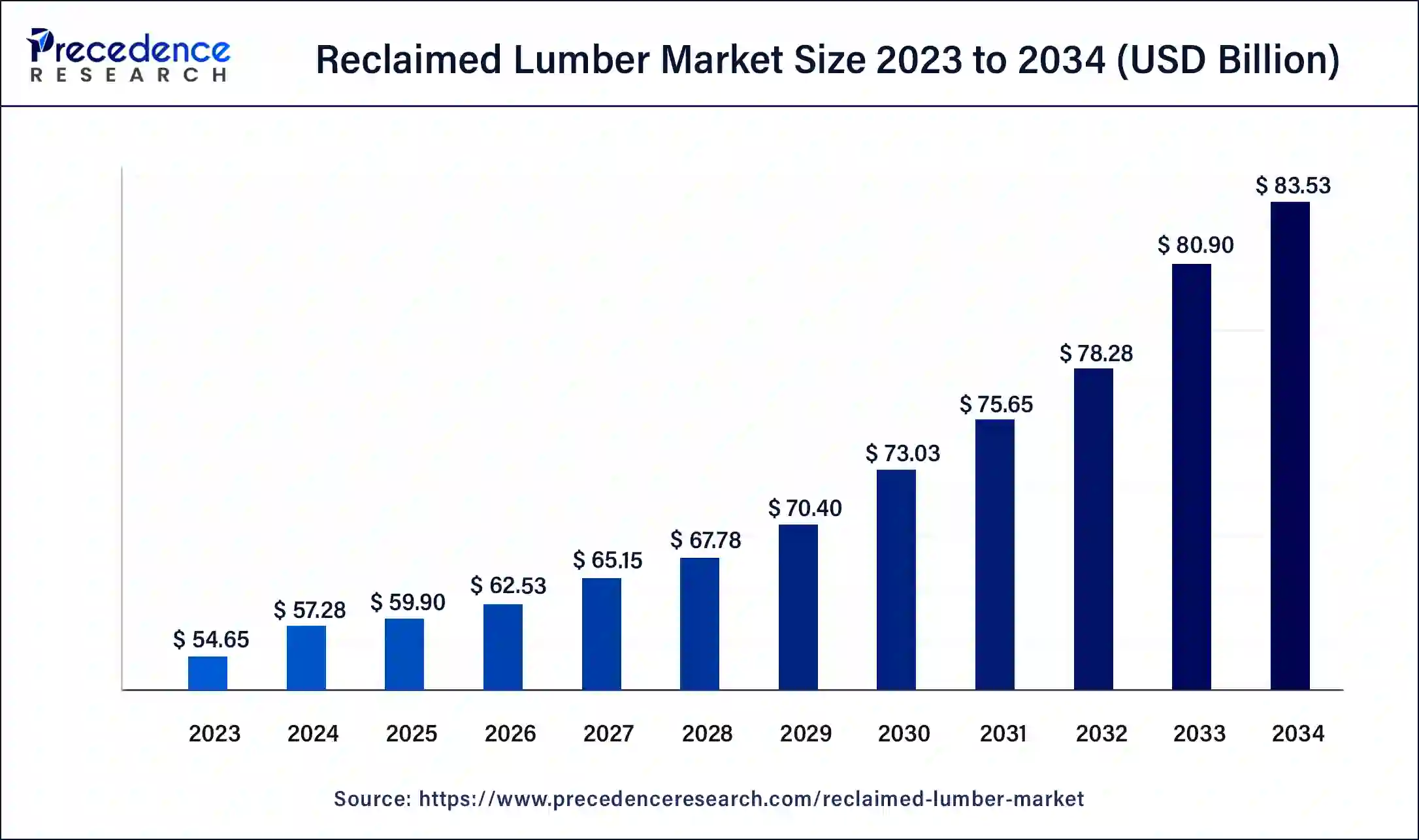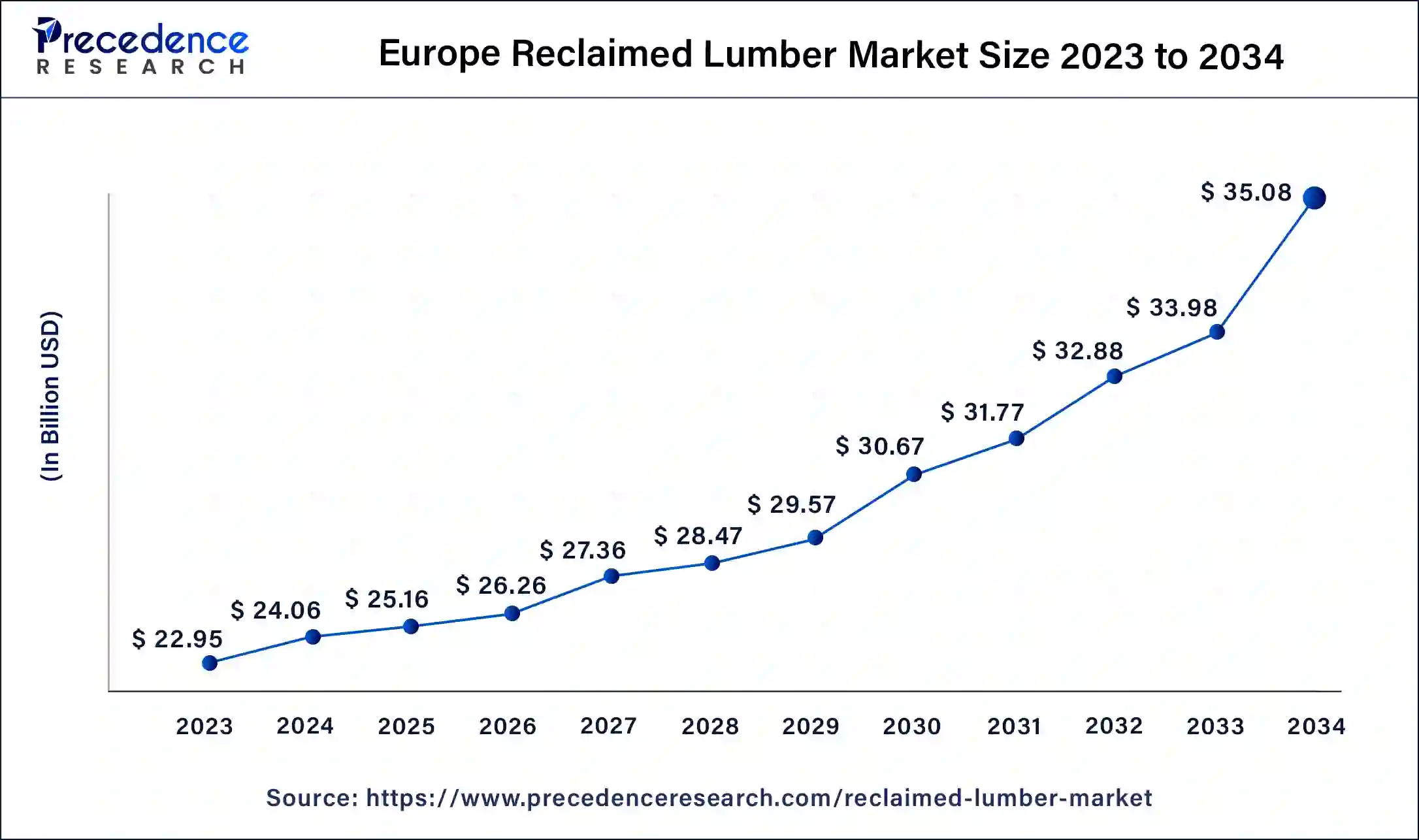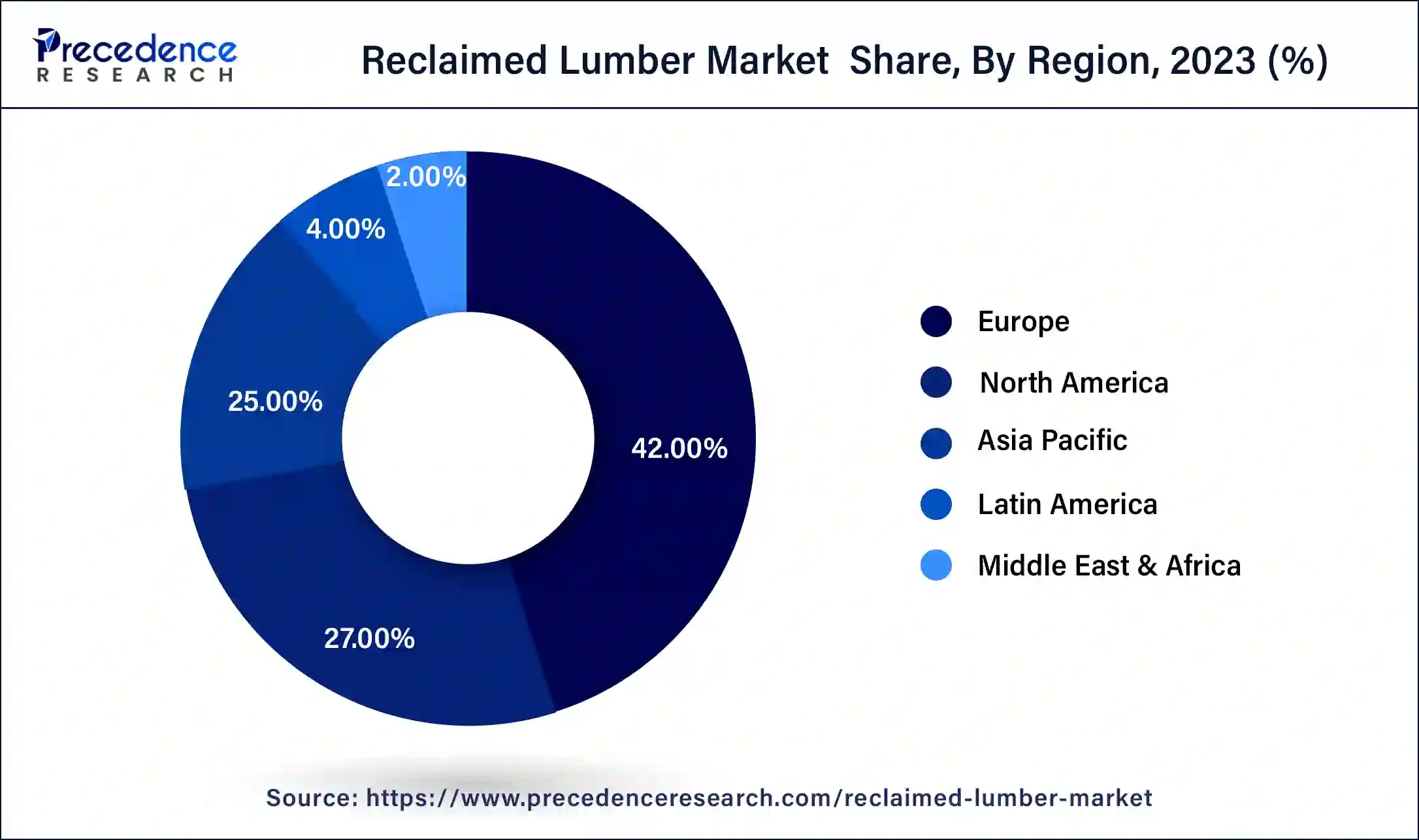Reclaimed Lumber Market (By Application: Flooring, Paneling, Beams & Boards, Furniture, Others; By End-Use: Residential, Commercial, Industrial) - Global Industry Analysis, Size, Share, Growth, Trends, Regional Outlook, and Forecast 2024-2034
The global reclaimed lumber market size was USD 54.65 billion in 2023, calculated at USD 57.28 billion in 2024 and is expected to reach around USD 83.53 billion by 2034, expanding at a CAGR of 3.84% from 2024 to 2034.

The Europe reclaimed lumber market size was valued at USD 22.95 billion in 2023 and is expected to reach around USD 35.08 billion by 2034, growing at a CAGR of 4% from 2024 to 2034.

Europe holds a major share of the reclaimed lumber market due to stringent environmental regulations promoting sustainable construction. The region's commitment to eco-friendly practices and circular economy principles has increased the adoption of reclaimed wood. High awareness among consumers, architects, and builders about the environmental impact of construction materials, coupled with government incentives, further drives the demand. The rich history and architectural heritage in Europe also contribute to the popularity of reclaimed lumber, aligning with the region's cultural emphasis on preserving and repurposing materials.
Asia-Pacific is poised for rapid growth in the reclaimed lumber market due to burgeoning construction activities, increasing awareness of sustainable building practices, and a rising demand for eco-friendly materials.

The region's economic development has spurred urbanization and infrastructure projects, driving the need for reclaimed wood. Additionally, a growing environmentally conscious consumer base and government initiatives promoting sustainable construction contribute to the market's expansion. The unique aesthetics and eco-friendly characteristics of reclaimed lumber align well with the evolving preferences in Asia-Pacific's dynamic and expanding construction landscape.
The reclaimed lumber market is witnessing significant growth in North America due to a rise in sustainable construction practices and increased environmental awareness. The region's commitment to green building certifications, such as LEED, is driving demand for eco-friendly materials. Robust construction activity, coupled with a strong emphasis on recycling, has boosted the popularity of reclaimed lumber. Furthermore, changing consumer preferences for distinctive and authentic designs have accelerated the use of reclaimed wood in both residential and commercial construction projects, contributing to the notable growth in the North American market.
Reclaimed lumber refers to wood sourced from old structures like barns or warehouses, slated for demolition. This wood is salvaged, processed, and repurposed for new construction or artistic projects. Its charm lies in the distinctive textures, colors, and patterns developed through years of weathering. This sustainable practice reduces the need for new timber, conserves resources, and lessens the environmental impact of logging. Reclaimed lumber is increasingly popular in both homes and businesses, reflecting a shift towards eco-friendly and visually distinct building materials.
Reclaimed Lumber Data and Statistics
| Report Coverage | Details |
| Global Market Size by 2034 | USD 83.53 Billion |
| Global Market Size by 2023 | USD 54.65 Billion |
| Global Market Size in 2024 | USD 57.28 Billion |
| Largest Market | Europe |
| Base Year | 2023 |
| Forecast Period | 2024 to 2034 |
| Segments Covered | Application and End-Use, Region |
| Regions Covered | North America, Europe, Asia-Pacific, Latin America, and Middle East & Africa |
The increasing construction sector
The construction industry's upswing is a key driver behind the growing demand for reclaimed lumber. As construction activities soar, there's a heightened requirement for eco-friendly building materials, and reclaimed lumber is meeting this need. Builders and contractors are recognizing the dual advantages, both in terms of cost-effectiveness and environmental friendliness that come with incorporating reclaimed wood into their projects.
The versatility and unique aesthetic appeal of reclaimed lumber make it a sought-after choice in construction endeavors. Not only does it align with the growing trend of sustainable building practices, but it also caters to the rising consumer preference for distinctive designs. The expanding construction sector acts as a key driver, propelling the market demand for reclaimed lumber as a preferred, environmentally conscious choice in the realm of contemporary construction projects.
Competition with new materials
The reclaimed lumber market faces constraints due to stiff competition with emerging eco-friendly materials. As innovative alternatives gain traction, the demand for reclaimed lumber is challenged by the introduction of new, sustainable materials that may offer comparable or enhanced qualities. Consumers and builders exploring novel options, such as engineered wood products or advanced composites, contribute to a dynamic market where reclaimed lumber competes for attention and market share.
The challenge lies in effectively communicating the unique benefits of reclaimed lumber, such as its historical character and reduced environmental impact, amidst the influx of newer materials. To overcome this restraint, the reclaimed lumber industry must strategically position itself, emphasizing its distinctive qualities and sustainable advantages to maintain a competitive edge in the evolving landscape of eco-conscious construction materials.
Renewable energy targets
Consumer preferences are increasingly shaping opportunities in the reclaimed lumber market as a growing number of individuals prioritize sustainability in their purchasing decisions. A notable shift in consumer attitudes towards eco-friendly and socially responsible products has positioned reclaimed lumber as a favored choice in construction and design.
The desire for authenticity and a unique aesthetic further fuels consumer interest in reclaimed lumber. As discerning buyers seek products that tell a story and contribute to a greener environment, the market for reclaimed lumber stands to benefit significantly from these evolving consumer preferences, presenting ample opportunities for growth and market expansion.
The furniture segment dominated the reclaimed lumber market in 2023; the segment is observed to continue the trend throughout the forecast period. In the reclaimed lumber market, the furniture segment pertains to the utilization of salvaged wood in crafting sustainable and distinctive furniture pieces. This trend is gaining momentum as consumers increasingly prioritize eco-friendly and aesthetically unique furnishings. The appeal lies in the inherent character of reclaimed lumber, showcasing weathered textures and historical nuances, contributing to the creation of bespoke furniture items. As a result, furniture manufacturers and designers are leveraging reclaimed lumber to meet the growing demand for environmentally conscious and stylish home and office furnishings.
The flooring segment is expected to grow at a significant rate throughout the forecast period. In the reclaimed lumber market, the flooring segment refers to the use of repurposed wood for flooring applications. This involves reclaiming and transforming aged wood from various sources into unique and sustainable flooring options. A notable trend in this segment is the rising popularity of reclaimed wood flooring due to its distinctive character, eco-friendly appeal, and increasing consumer preference for sustainable interior design. As more individuals and businesses prioritize environmental responsibility, the reclaimed lumber flooring segment is witnessing sustained growth and gaining traction in both residential and commercial settings.
The commercial segment is observed to hold the dominating share of the reclaimed lumber market during the forecast period. In the reclaimed lumber market, the commercial segment refers to the utilization of reclaimed wood in non-residential structures such as offices, hotels, retail spaces, and public buildings. A prominent trend in this segment is the increasing adoption of reclaimed lumber for interior design and furnishing in commercial spaces. Businesses are drawn to the unique aesthetic appeal and sustainability aspects of reclaimed wood, creating a demand for customized solutions that align with both environmental consciousness and distinctive design preferences.
The residential segment is expected to generate a notable revenue share in the market. The residential segment in the reclaimed lumber market pertains to the use of reclaimed wood in home construction and interior design. This includes applications such as flooring, furniture, accent walls, and structural elements. A notable trend in the residential sector involves homeowners and designers opting for reclaimed lumber to infuse character and sustainability into living spaces. The unique aesthetic appeal and eco-friendly nature of reclaimed wood align with the increasing preference for distinctive and environmentally conscious choices in residential construction and design.
Segments Covered in the Report
By Application
By End-Use
By Geography
For inquiries regarding discounts, bulk purchases, or customization requests, please contact us at sales@precedenceresearch.com
No cookie-cutter, only authentic analysis – take the 1st step to become a Precedence Research client